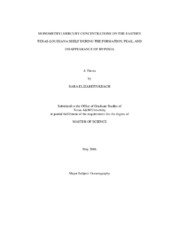| dc.contributor.advisor | Gill, Gary | |
| dc.contributor.advisor | Santschi, Peter | |
| dc.creator | Keach, Sara Elizabeth | |
| dc.date.accessioned | 2007-09-17T19:41:20Z | |
| dc.date.available | 2007-09-17T19:41:20Z | |
| dc.date.created | 2003-05 | |
| dc.date.issued | 2007-09-17 | |
| dc.identifier.uri | https://hdl.handle.net/1969.1/6003 | |
| dc.description.abstract | A study of monomethylmercury (MMHg) concentrations in the water and sediment of
the hypoxic zone in the northeastern Gulf of Mexico was conducted on several cruises
between April 2004 and May 2005. Surface water MMHg concentrations were low and
constant throughout the sampling period. Bottom water concentrations displayed a
seasonal trend: maximum MMHg concentrations were in June/July 2004, decreased to a
minimum in October 2004, and in May 2005 concentrations had begun to increase.
MMHg concentrations and MMHg as a percent of THg in surface sediment (0-2 cm)
also followed this trend. Bottom water dissolved oxygen and temperature displayed
inverse relationships with bottom water MMHg concentrations. This correlation between
dissolved oxygen and MMHg is typical for low-oxygen waters, but the relationship
between temperature and MMHg is relatively unique. A possible explanation is that
warmer summer temperatures inhibited bacterial methylation. Stratification intensity
(quantified as N2) was strongly correlated with bottom water MMHg concentrations,
indicating either increased methylation at the pycnocline or that the pycnocline inhibited
vertical mixing, thus limiting MMHg to the bottom water. Benthic flux estimations
indicate that sediment release of MMHg could be a significant source of MMHg to
bottom water. The presence of an oxygenated layer in the surface sediment could have
played a role in inhibiting MMHg flux during oxic conditions; a decrease in the
thickness of this layer under hypoxic conditions likely allowed MMHg to diffuse into the
bottom water. Dissolved oxygen seemed to play an important role in controlling
sediment MMHg concentrations with highest methylation rates in sediment under
hypoxic water. Overall, sites closest to the Mississippi River mouth displayed the highest MMHg concentrations. Further research will need to be done in this area to fully
characterize the relationship between biogeochemical parameters and MMHg
concentrations. | en |
| dc.format.extent | 415475 bytes | en |
| dc.format.medium | electronic | en |
| dc.format.mimetype | application/pdf | |
| dc.language.iso | en_US | |
| dc.publisher | Texas A&M University | |
| dc.subject | monomethylmercury | en |
| dc.subject | hypoxia | en |
| dc.title | Monomethylmercury concentrations on the eastern Texas-Louisiana shelf during the formation, peak, and disappearance of hypoxia | en |
| dc.type | Book | en |
| dc.type | Thesis | en |
| thesis.degree.department | Oceanography | en |
| thesis.degree.discipline | Oceanography | en |
| thesis.degree.grantor | Texas A&M University | en |
| thesis.degree.name | Master of Science | en |
| thesis.degree.level | Masters | en |
| dc.contributor.committeeMember | DiMarco, Steven | |
| dc.contributor.committeeMember | Rooker, Jay | |
| dc.type.genre | Electronic Thesis | en |
| dc.type.material | text | en |
| dc.format.digitalOrigin | born digital | en |


